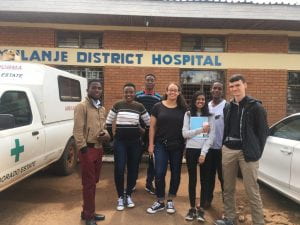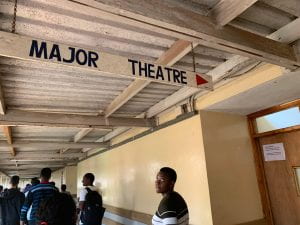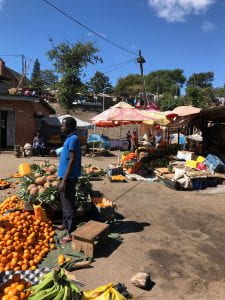
Somehow, a week already flew by in what felt like a matter of hours! This past Monday was officially our first day of work at the Polytechnic Design Studio. We had a warm welcoming introduction from the Dean of Engineering at Malawi Polytechnic University along with a few guest lecturers on the engineering design process with an emphasis on meeting the needs of the people. Our first assignment as interns was the “Just in Time” design challenge. Each team was a group of four student (one from each school) and the challenge was to drop a ping pong ball from one meter, and have it reach the ground in exactly 30 seconds. My teammates, Cholo, Maureen, and Chisomo, created a tube-like path to delay the ball before reaching the bottom. Unfortunately, our delicate paper, tape, and cardboard structure only took the ball 12 seconds to reach the bottom, ultimately failing the challenge, but winning with the longest time out of the other teams! I thought this was a neat way to ease into working with new people on a simple engineering project while observing the team dynamic.
On Tuesday, the we had an engineering skills crash course in Arduino and 3D Printing. In the 3D printing group, our mini project was to design and print a functional syringe. Learning the Solidworks design software seemed simple enough however, the difficult part was deciding how to configure the shapes to match those of the syringe. In the end, we were able to 3D print and assemble the entire syringe. I was proud of the way our group worked together to help one another and complete the finished product.

Later that day, Hillary (the Poly program coordinator) assigned us our teams and team projects before our hospital visits the next day. My team (Maureen, Cholo, and Tebogo) was assigned the neonatal hypothermia prevention in the transport between labor and neonatal wards. That evening, we each conducted background research and formed a set of questions to ask when interviewing the nurses at each hospital as well as specific areas to keep an eye out for. The next morning, we compiled all the questions before leaving feeling confident we would be able to get all the information necessary to complete the project. Over the next two days, we visited the neonatal, postnatal, and labor wards at Mulanje District Hospital and Zomba Central Hospital. Despite being welcomed into each hospital, I felt somewhat uncomfortable intruding in an intimate place where people go to seek help. None the less, we were grateful for the opportunity to observe the hospital’s daily activities as well as gain the staff’s perspective and protocol on the transport of hypothermic neonates between the labor and neonatal wards. Both visits allowed us to gain valuable insight into the realistic situation nurses experience and appeal to their specific requests and needs. From our visits, we discovered the main therapy for

hypothermia is kangaroo mother care (skin to skin contact between neonate and mother) with the occasional use of a radiant warmer if it is working. During transport the nurses currently, wrap the premature baby in dry cloth and carry it between wards. Despite the relatively short distance, the neonates still experience drastic decreases in temperature, increasing the risk of mortality. One key aspect we otherwise would have overlooked without interviewing the nurses are the premature babies born via C-section which occurs in the theater (operating room) significantly farther away from the neonatal ward than the labor ward. With this knowledge, we would need our solution to maintain the neonate’s temperature for a greater duration that anticipated.
Being able to visit two hospitals allowed us to split up into pairs and cross reference our findings. Because there was a lot of information we needed to gather within a short amount of time, we realized our initial hospital visit to Mulanje District Hospital was not as successful as we had hoped. We left with our answered questions only leading to more questions. Luckily, our teammates returned to Mulanje the next day while we visited Zomba Central Hospital and obtained all the information we needed. Both hospital visits allowed us to confirm our findings and interpret the information ideate possible solutions. Although we have only completed the research stage of the engineering design process, we are eager for the possible solutions to our project.

After a full week of work and travel, the interns and I took the weekend to relax and explore some of the local areas. Unfortunately, it rained (more of a continuous mist) all day so we did not venture far out of the lodge except in search of food. However, on Sunday we went attempted to go grocery shopping at the local market in Blantyre. Every day on the way home, we drive by the market which only piqued my curiosity further considering my initial thought of a market is mainly produce. However, once we reached the market there were people selling everything imaginable at every turn. The market itself seemed endless with vendor’s stall forming makeshift hallways (kind of like a fort made of scrap materials). Despite a few odd stares, I would say the trip was a success, but I really need to learn some more Chichewa besides “muli bwanji” (how are you) and “zikomo” (thank you).
Well that’s all for now but let’s see what new adventures are bound to happen in coming week. Stay tuned!
– S